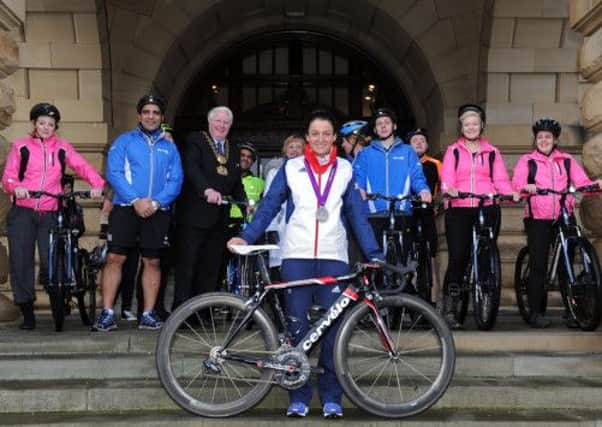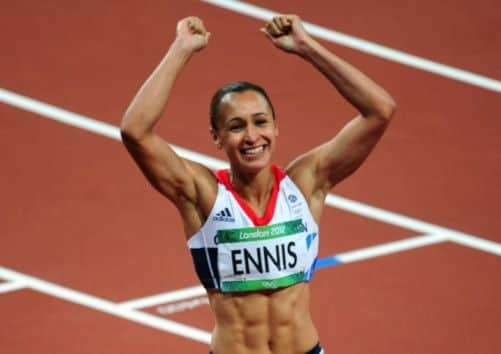It was the greatest show on Earth, but will we waste Britain’s Olympic legacy?


SIX months ago, Lizzie Armitstead hurtled through the driving rain on The Mall in front of Buckingham Palace to win silver in the women’s road race.
Roared on by a huge crowd that had braved the miserable conditions, the Otley cyclist won Britain’s first medal at London 2012 and kicked started what became a glorious summer of sport. No one could have predicted that by the time the Paralympics finished six weeks later the nation would have been so enthralled by the heroics of our sportsmen and women, many of whom, let’s face it, we hadn’t heard of before.
Advertisement
Hide AdAdvertisement
Hide AdYet the London Olympics and Paralympics captivated the public and produced some of the greatest moments in British sporting history. Even before the games finished there was a lot of talk about its “legacy” and the need to not only inspire the next generation of athletes, but people of all ages who perhaps hadn’t been interested in sport before.


In a country where childhood obesity has become an epidemic, could we really, for all the Olympic fever, get people off their sofas and on to their bikes or into the local park?
In December, a Sport England survey showed that the number of people playing sport at least once a week grew by 750,000 last year, boosted by the success of the Olympics. It also revealed that more women than ever before were taking part in sport and that more disabled people are participating in sport at least once a week, although the number of 16-25 year-olds doing sport had largely remained the same.
Cycling, perhaps not surprisingly given the herculean feats of Sir Bradley Wiggins and co, has seen the most significant rise – with 200,000 more people riding compared to the last annual figures. Two-thirds of the sports surveyed showed a positive trend over the past year with athletics, judo, hockey, netball and swimming among those growing in popularity. Cricket, which endured the wettest summer for a century, was among the sports that has seen a decline.
Advertisement
Hide AdAdvertisement
Hide AdSports Minister Hugh Robertson said last week that six months on from the opening ceremony the Olympic legacy had “extremely strong foundations” in place. He was speaking as Sport England revealed its Inspired Facilities Olympic and Paralympic legacy fund had supported more than a thousand local communities up and down the country and that £16.6m of National Lottery cash was going to 310 sports groups in England.
Yorkshire has done well out of all this with 29 sports clubs, ranging from Harrogate Racquets Club to the Feathersone Rovers Foundation, receiving a combined total of £1.4m. Among the local beneficiaries is Stamford Bridge Community Pool, near York, which is getting £50,000 to modernise and extend its facilities.
The club’s secretary, Caroline Calvert, says the money will make a big difference. “It means we can upgrade the quality of our facilities, improving energy efficiency, reducing operating costs and making the pool more attractive and user-friendly,” she says. “The overall impact will be to improve pool usage by all sections of the local community and to provide them with a facility that they will want to use for many years to come.”
In South Yorkshire, too, the situation is encouraging. Lorenzo Clark, director of operations for Sheffield International Venues (SIV), which operates 19 sports and leisure facilities including the English Institute of Sport, says they have seen significant increases in the number of people taking part in sport.
Advertisement
Hide AdAdvertisement
Hide Ad“Prior to the Games, we were already hitting participation targets and the medal successes of athletes who train in our facilities, such as Jess Ennis, Anthony Joshua and James Crisp, have inspired even more people to get involved with sport in Sheffield.”
He says that athletics attendances have increased by 80 per cent from 262 at the end of July 2012, to 470 this month. They have also seen an 11 per cent increase in those taking part in gymnastics and plan to use key sports like badminton and swimming as a way of encouraging even more people to get active.
However, although there are no shortage of reasons to be optimistic about the future of sport participation in this country, there are still concerns. In Sheffield, the athletics stadium where Jessica Ennis trains is threatened by closure and demolition because of budget cuts.
The city council says the taxpayer currently subsidises Don Valley Stadium to the tune of £700,000 a year, a situation which may not be sustainable because the authority must save £50m in the next financial year following central Government cutbacks.
Advertisement
Hide AdAdvertisement
Hide AdTim Lamb, chief executive of the Sport and Recreation Alliance, says there is a lot still to be done. “Producing a sporting legacy is no mean feat and we’ll need to work hard at it, particularly in these economically tough times, to ensure that issues like the lack of affordable facilities do not prevent the legacy from being achieved.
“This is especially important bearing in mind that around two-thirds of all community clubs have to hire pitches, courts, or other places to play. In particular we need a coherent strategy to mitigate the impact that local authority cuts will have on access to affordable and quality sports facilities in the next few years, otherwise the risk is that too many local facilities, like the Don Valley Stadium, could be lost.”
Despite these concerns, he believes we are on the right track. “I think the inspiration and interest in sport that’s been generated has been undeniable, and what’s important now is that we do all we can to ensure we convert as much of this interest into long-term increases in participation. The positive signs are there, with lots of fantastic programmes being carried out by sports governing bodies being taken up by the public.”
Mick Hill, an elite coach at Leeds Metropolitan University who does javelin training with Ennis, believes we’re still benefitting from the feelgood factor of the Games. “There’s an awful lot of people who have been enthused and motivated by what they saw on their TV screens during both the Olympics and the Paralympics.
Advertisement
Hide AdAdvertisement
Hide Ad“People were watching some sports they’d probably never seen before, and I think it has inspired a lot of them to go out and give something new a go. We runs kids camps here in Leeds and the numbers coming in have been very good over the last six months,” he says.
But it’s one thing taking up a new sport and playing on a pleasant summer’s day, it’s another to drag yourself out in the depths of winter. “When the weather’s bad and there’s snow on the ground or it’s pouring with rain that’s when it’s hard and that’s when reality bites for a lot of people, although for others it’s the memories of the Olympics that drives them on.”
Becoming an elite athlete takes time and dedication. “There were a lot of things in place long before the London on Olympics because you don’t become an Olympic champion overnight. It can take 10 or 20 years.”
But is there enough money available to fund all the different sports and provide the right amenities? “What the Olympics proved was that this country can deliver excellence across a number of sports. We could always do with more facilities and better facilities but sporting excellence doesn’t happen just by chucking money at it, you need good coaches and facilities and I believe we are in a very good place right now.”
Advertisement
Hide AdAdvertisement
Hide AdAs for the legacy, it’s too early to tell. “During the summer we saw sport in all its glory, but we won’t know for at least another eight years what the legacy really is,” he says. “But we’ve had the Brownlee brothers training up here and when people see them they realise that Olympic champions don’t just live in far away places they can also live in their neighbourhood, and when they see them with their medals they realise that they’re just like them and that’s the best motivation you can get.”
THE OLYMPIC LEGACY SO FAR
In December it was announced that £493m was being committed to 46 sports over the next four years, and that 15.5 million people are now playing sport every week, more than ever before.
£16.6m of National Lottery funding has been given to 310 sports clubs across England, with £1.4m of this going to 29 sports groups in Yorkshire, including £50,000 to Aireborough and Nunroyd Sports Association for floodlights at Aireborough RUFC and £50,000 for a new pavilion at Whixley Cricket Club in York.
Sport England says 1.5m people take part in sport in Yorkshire every week, an increase of 60,000 on last year and over 200,000 since the Olympics bid was won in 2005.